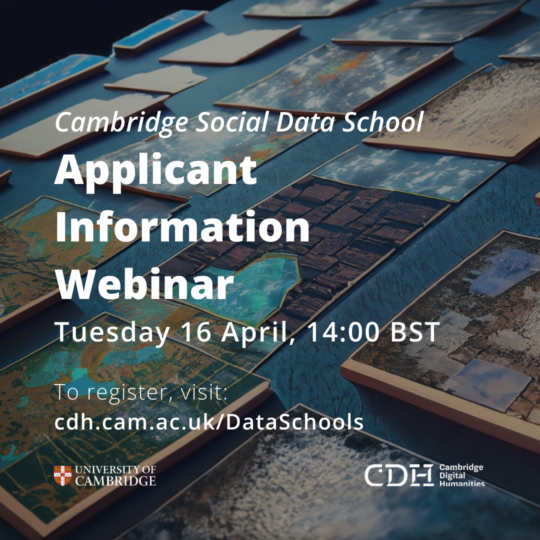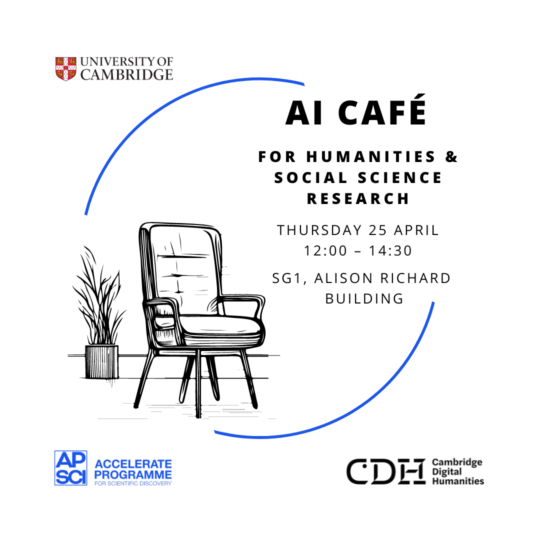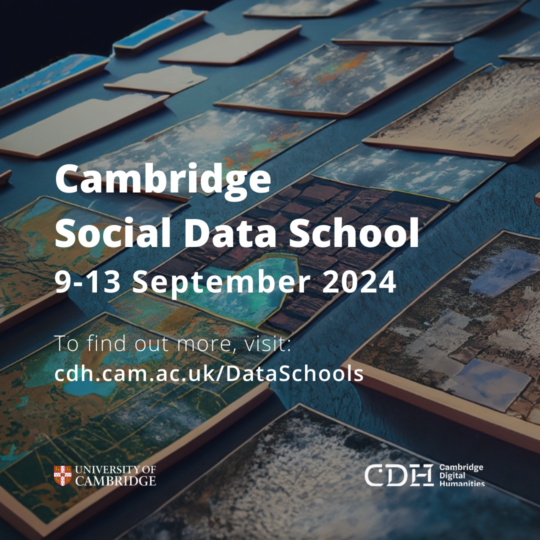| 1 May 2019 | 11:30am - 3:00pm | Room B3, Institute of Criminology | |
- Description
- Programme
Description
Free to attend but places are limited. Book your place here or use the online registration link on this page.
Workshop conveners: Professor Johanna Drucker (UCLA); Dr Anne Alexander (Cambridge Digital Humanities)
Visualisation is a primary mode of knowledge production, but it is often used as a secondary mode of display in highly conventional formats that limit the conceptual dimensions of research. The goal of the workshop is to explore possibilities for innovations in visualisation that will expand the vocabulary of current standards in ways that might suit humanities researchers working in digital methods. To do this, we intend to explore in-depth case studies that allow us to consider several fundamental data-types and structures within digital humanities work: ontologies/typologies (classification systems), mapping/spatial visualisation; chronology/temporality.
Programme
| 11.30am | Session 1: Case Study Pesentation Case study project: The Bug Hunt (Faculty of Education, University of Cambridge / CDH Learning) The Bug Hunt is a pedagogical initiative which introduces students and staff in the University of Cambridge to quantitative methods in the study of literature through the process of creating a corpus of 19th century literary works read by children, and developing visualisations of the presence (and absence) of ‘bugs’ (insects and other similar creatures). This project raises many issues about names, identities, values, affective aspects of perception that are all pertinent to open linked data initiatives and aggregation. How do we inflect the standard visualizations in ways that embody some of the affective dimensions of story-telling? What are the limits of quantitative analysis in generating visual display? What connection between close and distant reading techniques could be supported by visualizations and interfaces? Does this matter and is it worth it? How do we relate imaginative literature and its nomenclature to scientific knowledge and horticultural or ecological practices? This project raises many issues about names, identities, values, affective aspects of perception that are all pertinent to open linked data initiatives and aggregation. Presenter: Julie Blake Case study project: Visual Entropy and the Visualisation of Uncertainty (University of Newcastle) Uncertainty is a concept that can be complex to present in meaningful, comparable ways to both expert and non-expert audiences. Inherently it involves a need to comprehend a lack of a property and it is well known that human decision making is both ignorance averse and influenced differentially by the use of negative vs positive framing of decisions. Negative concepts such as uncertainty are less often chosen outcomes in decision making than positive concepts such as certainty. This project introduces a definition of visual entropy that may find uses in a range of visualisation applications. In essence, we suggest visual entropy should relate to visual complexity, so that low visual entropy describes smooth visual signals and high visual entropy describes complex, more disordered, visual signals. This allows us to begin to define a scale of visual entropy and to implement this we propose a way to quantify visual entropy using existing mathematical tools. We then hypothesise that there is a natural semantic fit between an increasing scale of visual entropy of shape and an increasing scale of uncertainty in data that can provide a novel way to define a set of glyphs for representing uncertainty in data visualisations. Presenters: Professor Nick Holliman, Sara Fernstad and Mike Simpson Case study project: Mapping female entrepreneurship in England and Wales, 1851-1911 (CAMPOP, University of Cambridge) While there has been considerable research on the economic geography of eighteenth- to twentieth-century England and Wales, this includes little discussion of the geography of business proprietors or different environments of entrepreneurship. This is surprising, since the development of the economy into differentiated local industrial districts had been well-understood since Alfred Marshall (1919; 1961) introduced the concept, and the dominance of local market demand and supply opportunities was embedded in early writers on entrepreneurship and economic history. The ‘Drivers of Entrepreneurship’ project team has started to unpick the distribution of business proprietors throughout the country, how districts differed in level and form of entrepreneurism, how male and female participation differed, and how different sectors interacted across and between districts. However, mapping entrepreneurship is not straightforward. The most commonly used measures, the entrepreneurship rate and the entrepreneurship share, are either heavily affected by the number of workers in the geographical unit under consideration (and thus by the firm size distribution) or by population density. Neither map therefore provides a satisfactory visualisation of developing business environments. This presentation explores different ways of conceptualising entrepreneurial environments, using the female business population in Victorian England and Wales as an example. It considers firm size distributions, population, and occupational diversity and how this changed over time and space. Presenter: Carry van Lieshout |
| 12.15 | Lunch |
| 12.45 | Session 2: In-depth discussion of case studies and other issues in visualisation |
| 2.15pm | Summary of findings and discussion with regard to data models, structures, and display protocols. |
| 2.45pm | Wrap up |







